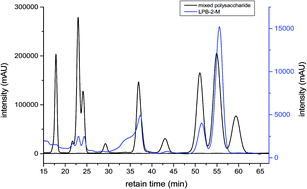Crude longan polysaccharide (CLP) was extracted from longan (Dimocarpus longan Lour.) pulp. Its chemical composition was determined by chemical analysis, high-performance liquid chromatography (HPLC) and gel permeation chromatography (GPC). The flow and viscoelastic behavior of a CLP solution was investigated by carrying out steady shear and small amplitude oscillatory shear (SAOS) experiments, respectively. The results showed that the CLP solution was a polysaccharide–protein complex. The rheology experiments showed that it underwent a pseudoplastic flow at various shear rates (0.1–100 s−1). Both the flow behavior and viscoelastic behavior of CLP were influenced by cations such as Na+ and Ca2+. Increases of the apparent viscosity, G′ and G′′ accompanied the addition of Na+ and Ca2+. A polysaccharide named LPB-2-M was obtained from isolation and purification of CLP; this polysaccharide was shown to consist of a single component due to the narrow molecular weight distribution, which was evident by the polydispersity index (PDI = Mw/Mn). The average molecular weight (Mw) of LPB-2-M was 80 kDa.

